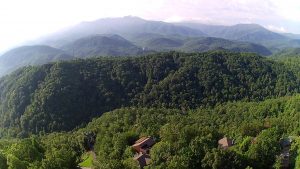 70 miles of the trail pass through the Great Smoky Mountains National Park. Within the Park’s borders, the trail crosses from Davenport Gap near Big Creek on the east to Fontana Dam, N.C. on the southwest, reaching a halfway point at Newfound Gap. It passes near or over several of the highest peaks in the eastern United States. The Appalachian Trail winds up over the highlands through grassy balds and descends into the valleys to briefly join other trails.
70 miles of the trail pass through the Great Smoky Mountains National Park. Within the Park’s borders, the trail crosses from Davenport Gap near Big Creek on the east to Fontana Dam, N.C. on the southwest, reaching a halfway point at Newfound Gap. It passes near or over several of the highest peaks in the eastern United States. The Appalachian Trail winds up over the highlands through grassy balds and descends into the valleys to briefly join other trails.
A good place to start is the Sugarlands Visitors Center on Route 441 at the Gatlinburg entrance to the Great Smoky Mountains National Park. There are nature exhibits, a short film, guidebooks, maps, and park rangers who give lectures guided strolls, and answer questions. This is also where you would pick up your camping, hiking, or fishing permits.
The most popular drive through the park is Newfound Gap Road, which is 26 miles long and crosses the park to the southeast. It begins at Sugarlands which is at an elevation of 1,436 feet, it rises to more than 5,000 feet above sea level at Newfound Gap. The road descends down to 3,000 feet to Oconaluftee Visitors Center at the main entrance to the park from North Carolina. Oconaluftee Visitors Center is also a treasure trove of information and the adjacent Mountain Farm Museum will introduce the visitor to the rural heritage of the early settlers. Newfound Gap Road is a gradually unfolding botanical journey that spans the five vegetation zones a traveler would encounter if traveling the hundreds of miles to Maine. There are scenic overlooks along the way, roadside exhibits and trailheads for the hikers. There is also the memorial where Franklin D. Roosevelt stood to dedicate the national park in 1940.
The most spectacular stop is Clingman’s Dome, accessible by a 7-mile side road. At 6,643 feet above sea level, Clingman’s Dome is the highest point in the Smokies and the third highest mountain east of the Mississippi. Visitors can drive almost all the way to the top and then hike the last half mile to the lookout tower. Take it slow because the high altitude means the air is thinner, but the fantastic, panoramic view is worth the effort.
Other motor trails exist for the “armchair” visitor. The most famous is the Cades Cove Loop, which is also a historical tour of those who settled in the valley. Northeast of Gatlinburg off Highway 321 is the Roaring Fork Motor Nature Trail Loop which takes you up the western flank of Mt. LeConte. This paved, narrow, winding jewel of a road fords streams and cuts across a deep gorge. It is closed during the winter and at all times to buses, trailers, and RVs. At the visitor centers you can also find out how to get to the various dirt roads that will take you further back into the mountains and off the beaten path.
There are about 150 trails covering over 900 miles and there are trails for everyone’s stamina, interest, and level of expertise. Twelve self-guiding nature trails, ranging in length from 1/4 mile to a mile roundtrip, were selected and developed by Park naturalists for their interesting natural history, beauty, and accessibility. The new All-Access Nature Trail, 0.5 miles south of Sugarlands on Newfound Gap Road, was specially designed for the handicapped, parents with young children, and older couples.
Back country hikers staying overnight need to get a hiking permit first. Whether your planned hike is short or long, it is always a good idea to have on dependable hiking boots, wear multiple layers and carry rain gear. The temperatures are cooler in the trees and get progressively so the higher up you go. The higher elevations also see more precipitation than the lower ones, so be prepared. Bring along drinking water as the streams are not drinkable and be sure to carry out all that you bring in, particularly your trash.
All four seasons have their own magic beauty. In spring the delicate wildflowers decorate the mountains. In summer all is a lush, cool, vibrant green. In fall the colors red and gold splash themselves across the mountain sides. In winter the air is crisp and clear and often sparkling with snow and ice.
Another great way to learn more about the Great Smoky Mountains is to attend Pigeon Forge’s popular Wilderness Wildlife Week in May. There are guided hikes, photography workshops and lectures ranging from the flora and fauna found in the park to what’s new in outdoor hiking gear. All walks and lectures are free to the public. The Great Smoky Mountains National Park is an endless source for discovery and inspiration.
See more on the Smoky Mountain National Park at this website.
